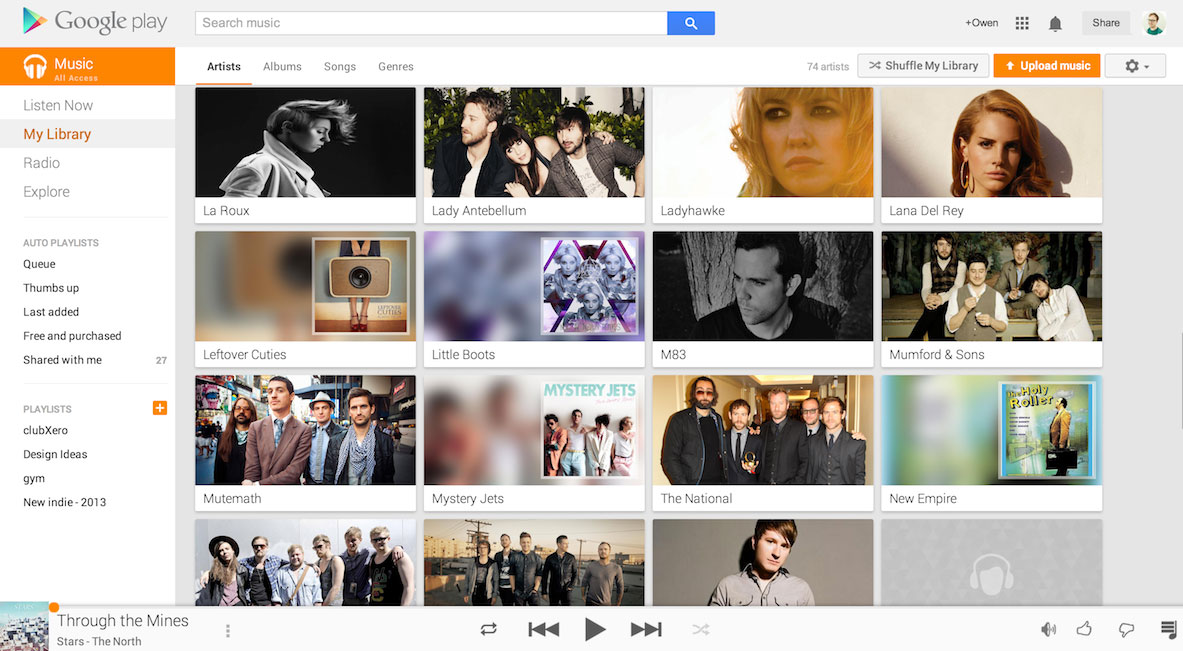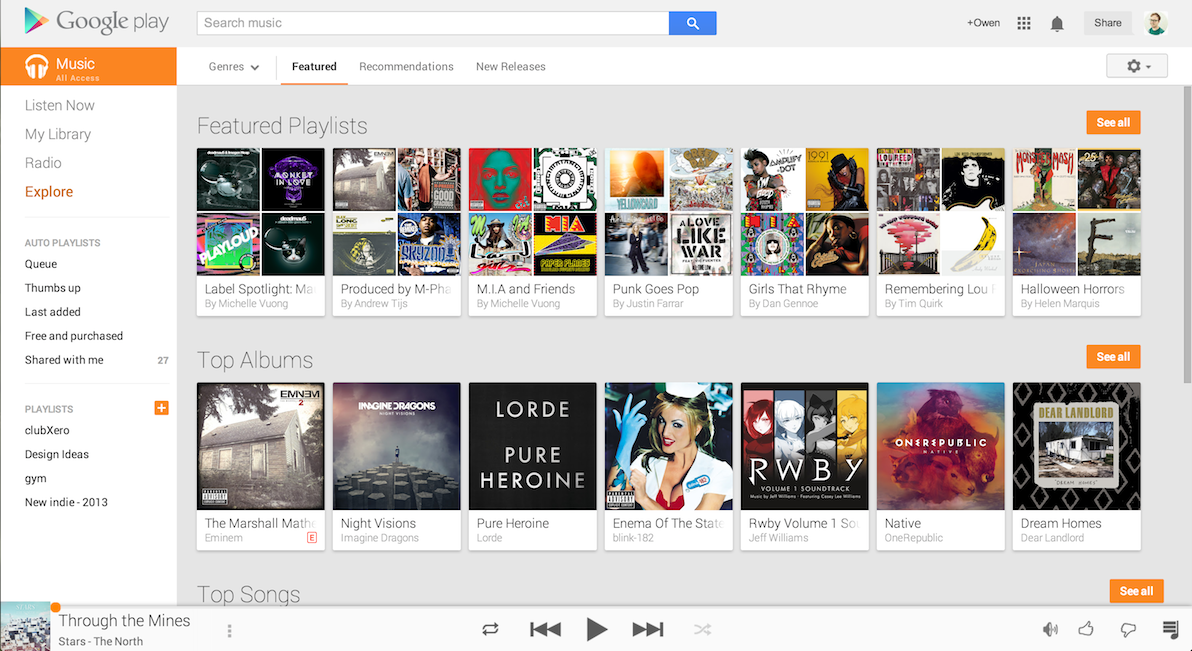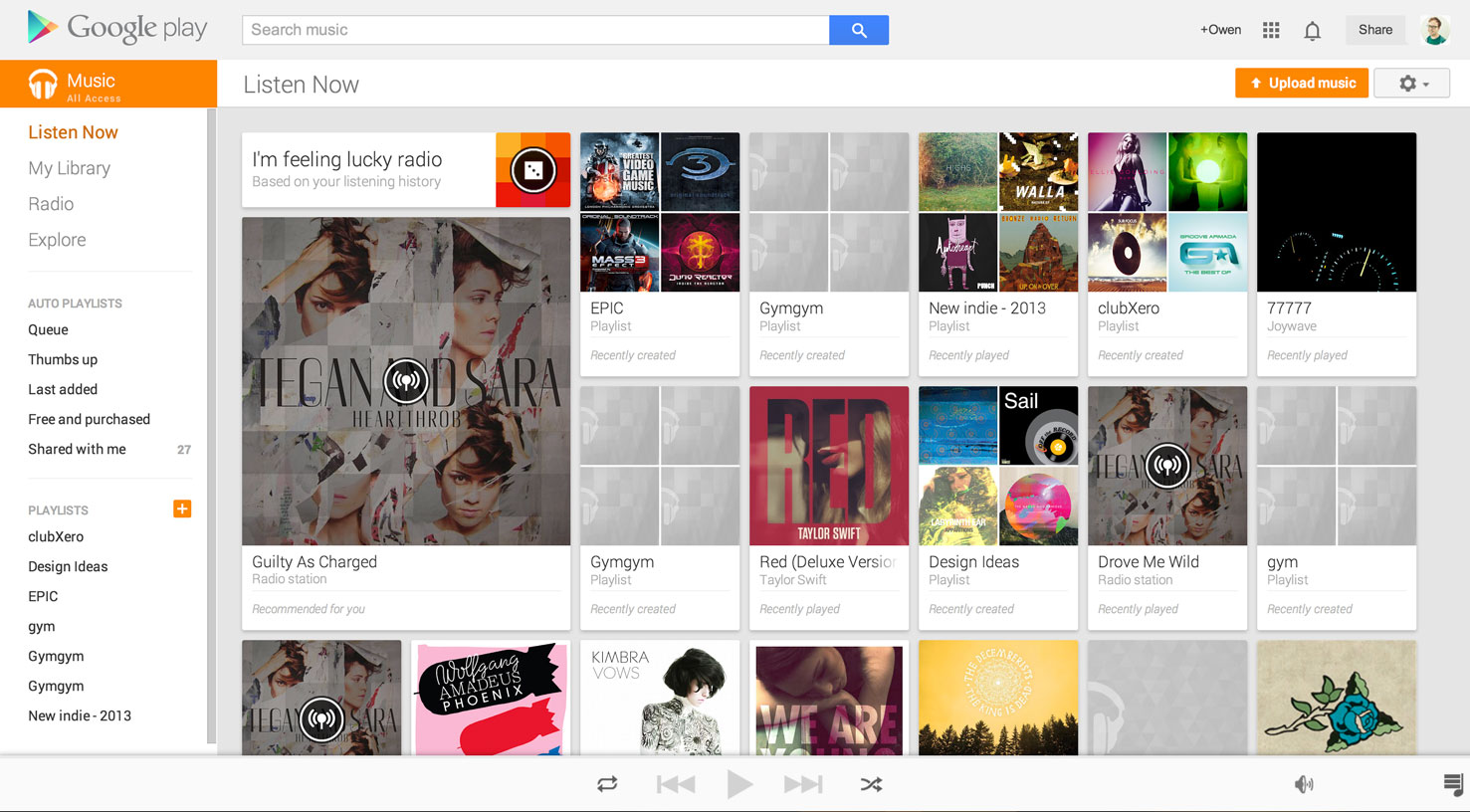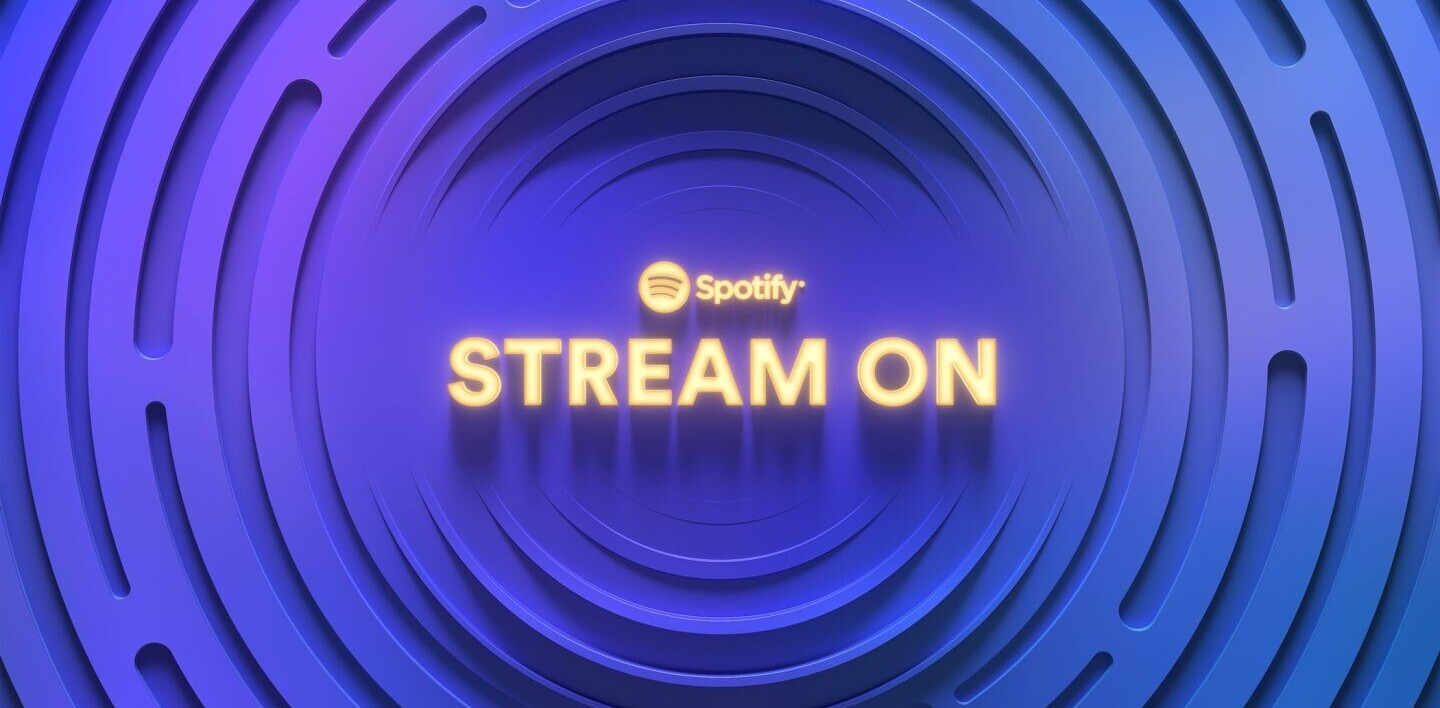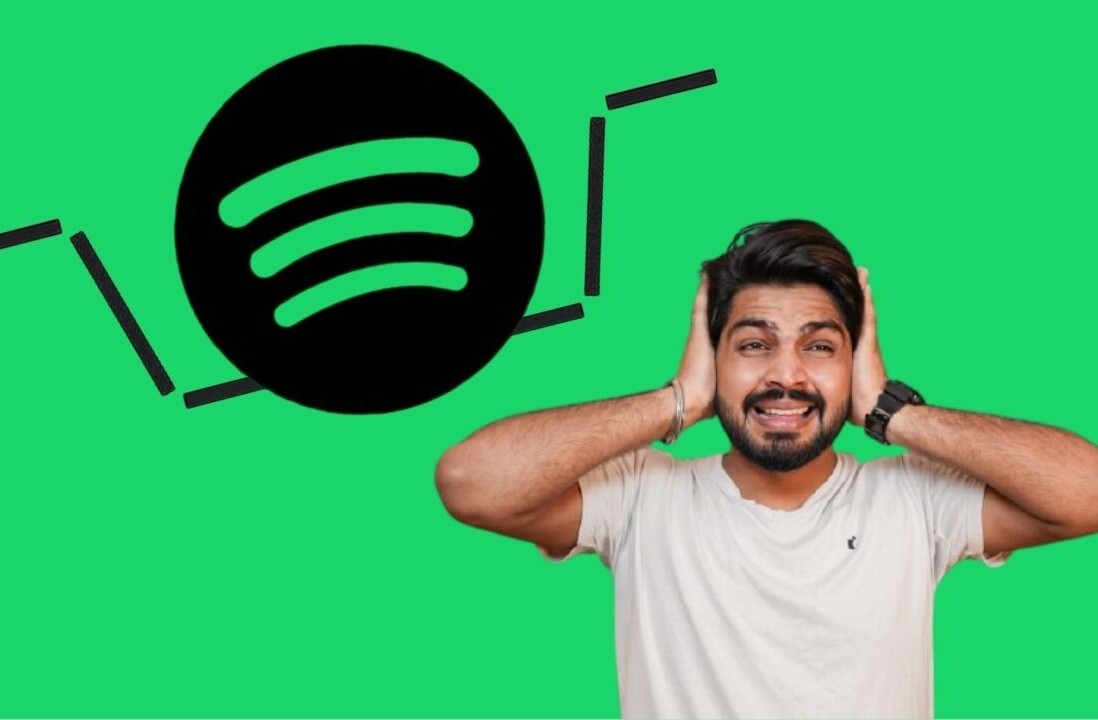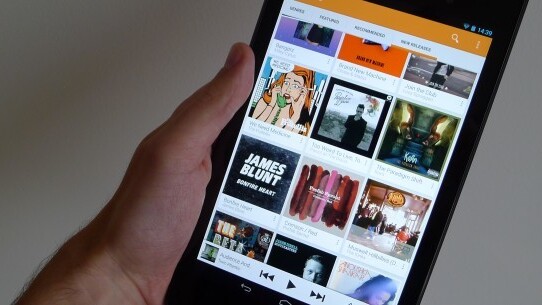
Ever since Spotify was launched I’ve been a subscriber and huge fan of the service. I’ve sworn by it for years and have built extremely large playlists on the service and synchronized them with all of my devices.
I’d tell my friends of the benefits of Spotify over competitors like Rdio — such as their extensive catalog of music — but I’ve fallen out of love with the service. Over the last few years it seems like Spotify hasn’t been improving the service much aside from adding new discovery features; their desktop and mobile apps are much the same as they were over a year ago and they don’t seem to be seeing any change with each update that’s pushed.
The features that users really want — such as better ways to track their music and better desktop/mobile applications — haven’t been added and there aren’t any noises from the company about adding them in the near future.
With the announcement of Google Play Music All Access for iOS, it was finally time to make the jump from Spotify to Google’s offering. The results have been extremely freeing and Play Music exposes just how far behind Spotify is falling. Both Spotify and Google offer a subscription service that allow access to the entire music catalog and both sell for just $9.99 US / month.
Giving back your music
One of the hardest parts of switching to Spotify was losing my years of meticulously curated music. Spotify never included a way to upload (or even match up) the music that people had accumulated over the years other than offering to play your local iTunes library from inside the app itself.
Google Play Music All Access is much more powerful (despite being a mouthful to say) as it allows you to upload all of the non-DRM music you already own, making it accessible from not only any computer but mobile devices too. The ability to upload music is extremely useful considering that no subscription service has the perfect catalog, so when there’s something missing you’re able to just purchase it yourself and then upload it into Google’s cloud.
It’s extremely simple to do, too. You just download the music manager app and tell it what music you want to upload (a folder or your entire iTunes library) and it’ll upload everything pretty quickly. There is a limit of 20,000 uploaded songs right now which is a little disappointing for those with large libraries but we’d hope Google will eventually allow users to purchase additional storage.
Spotify does have a better streaming collection but Play Music’s is extremely close in our tests. In a test with a playlist of 466 songs that we imported from Spotify, there were 40 songs unavailable on Play Music. That said, since you’re able to upload the tracks yourself anyway it doesn’t matter too much; especially considering that when a song is missing on Spotify there’s nothing you can do to add it.
A sensible way to manage music
Spotify’s glaring omission is any sort of library management. If you’ve used Spotify at length, you probably have up hundreds of playlists — mostly consisting of a single album or artist in each — since the company doesn’t allow you to add music to your library or track it in any other way.
Play Music does this a lot better and has a library feature that isn’t dissimilar to iTunes but lets you add music you own as well as those that are available through the subscription streaming service. This feature alone is extremely powerful and makes it much easier to track artists you like as well as leaving playlists to do what they were made for. It also automatically adds album art, making the library much more visually appealing than a simple list of songs.
Additionally, the full library functionality works across mobile and the Web which means that essentially anything with an Internet connection will give you access to your entire music collection. With the release of the iOS app, Apple device owners are able to synchronize artists and playlists for offline playback just like Spotify but with the added ability to also sync their uploaded music.
You’re also able to purchase music you like directly through Play Music which adds it to your library and offers the ability to download an MP3 version for safe keeping.
Powerful discovery tools
Play Music is full of powerful music discovery tools, offering the ability to listen to radio stations that play music similar to things you already like as well as an additional ‘explore’ section that shows popular albums, emerging artists and trending playlists.
If you’re completely unsure what you want to listen to, Play Music has a “listen now” section that selects songs based on your listening history, library and playlists that it thinks you should listen to.
It also has Google’s famous “I’m feeling lucky” button that will just randomly start playing you something randomly. This mode is extremely powerful; it plays a mix of songs from your library as well as your listening history and a selection of songs that it thinks you’ll like based on the two combined. This is my favorite way to listen to music and is extremely useful when you’re feeling lazy. When you have a large collection like I do, it can be hard to actually pick something to listen to but with “I’m feeling lucky” you get the best of the discovery tool and your own library.
Spotify has similar discovery tools which are extremely powerful but their music sharing process requires the users you want to share the music with to have an account with them. Sharing a link to a song on Spotify is unpredictable; sometimes it opens on the Web and sometimes it opens on the desktop.
With Play Music, you’re able to share music with anyone that has a Google account or directly to Google+ (unfortunately not to any other networks such as Facebook or Twitter) where friends can stream the song without a Play Music account.
The problems
Play Music isn’t perfect, though. This becomes obvious when you attempt to export playlists from Spotify into the service, a process that is slow and quite unsupported. Google doesn’t offer an API for the service yet which means it is hard for developers to build apps that use the platform. That said, a tool called Portify was released by a third party that allows you to import playlists from Spotify manually using a workaround. Unfortunately, it’ll require quite a few steps to move everything across but despite it being difficult, remember it only needs to be done once.
On top of this, Play Music doesn’t have a desktop application yet for both Windows and OS X. It doesn’t matter too much since the website is extremely powerful but most users like to have something that runs on the desktop for when they don’t want to open a browser. This also means there isn’t any offline sync when you’re away from the Internet with your computer which is frustrating and Google is yet to state if they plan to add this functionality or not.
Spotify now on notice
Now that Play Music is available on iOS, Spotify is on notice. The company isn’t moving fast enough or adding any major new features and Google has already outpaced them with Play Music. The ability to mash your own music collection with Google’s subscription service is extremely powerful and allows users to avoid having to go and find everything they’ve ever liked.
Spotify’s lack of a library is a major pain point; the fact that they don’t have a way for users to save the music they like outside of making playlists or starring songs is a problem. It leads people to forget about artists and discourages the age old metaphor of collecting music in a library for later listening.
While Play Music isn’t perfect, it’s far more powerful than Spotify currently is. I’ve transferred all of my playlists over to Play Music, uploaded all the music that I had shackled to iTunes and will be cancelling my Spotify subscription very soon. I’d encourage anyone else to do the same, you won’t miss Spotify in the slightest.
Now that Google’s offering is available on Android and iOS, it’s a formidable competitor with a catalog to back it. It doesn’t seem like Google advertises the service very much, but now that it’s more well rounded the company should start pushing harder to take market share from the likes of Spotify and Rdio.
If you sign up for Play Music there’s a free one month trial of All Access, which means you can stream and synchronize all music that’s available through the service.
Read Next: Our in-depth guide to Google Play Music All Access
Get the TNW newsletter
Get the most important tech news in your inbox each week.

